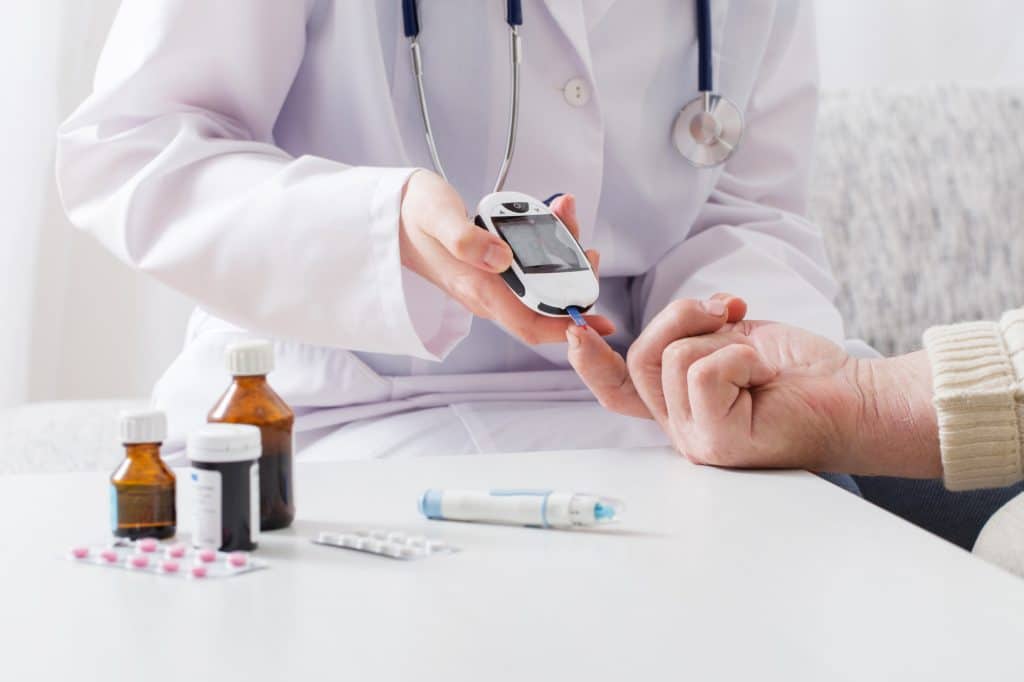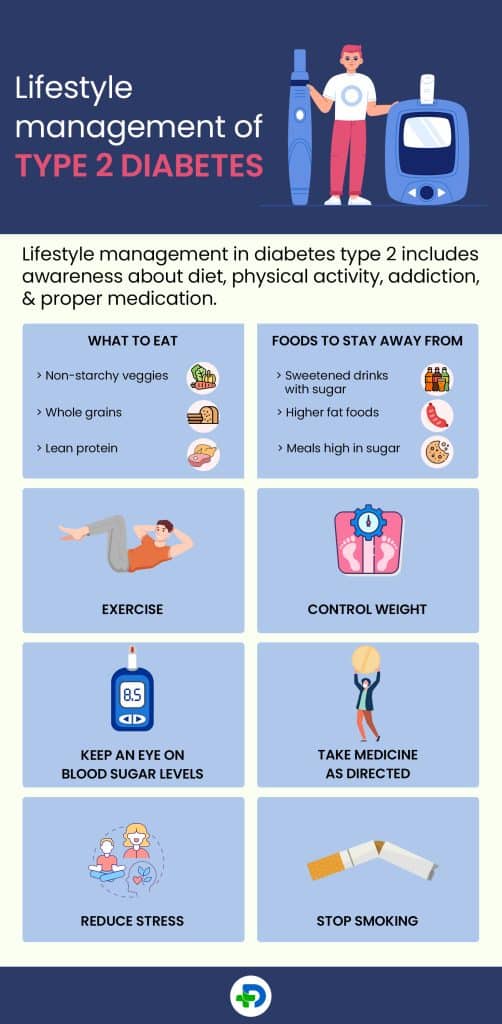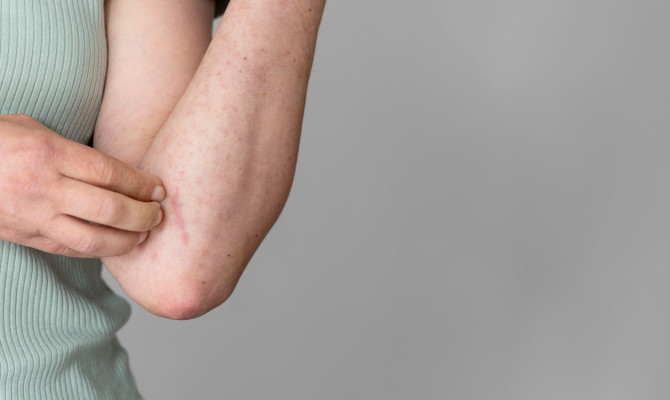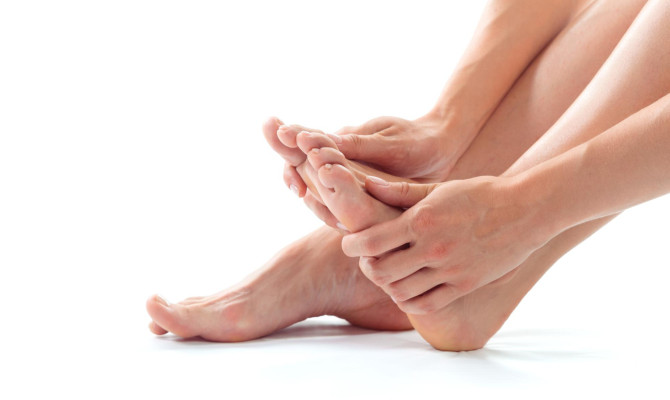Type 2 Diabetes : Symptoms, Complications, and Management

- Diabetes
- 14 Aug 2023
Overview
What is Type 2 Diabetes ?
A chronic disease called type 2 diabetes affects how your body metabolizes sugar, which serves as your body’s primary fuel source. When you have type 2 diabetes, your body either produces insufficient insulin or resists the initial insulin, a hormone that controls the entry of sugar into cells. This may result in elevated blood sugar levels, which may create several other health issues over time.
90% of instances of diabetes are type 2, the most prevalent type and is frequently correlated with lifestyle choices, including food and activity.1Symptoms | Researched based study from Cdc.gov

Symptoms
What are the symptoms?
Other people may not experience any symptoms at all, which can differ from person to person. Here are a few of the typical signs:
- Frequent urination and increased thirst
- Blurred vision
- Fatigue or constant tiredness
- Cuts or wounds that take a while to heal
- Numbness or tingling in the hands or feet
- Unexplained weight gain or loss
- Increased appetite
- Itchy skin and a dry mouth
- Infections that recur, such as gum and skin conditions .1Symptoms | Researched based study from Cdc.gov
Causes
What are the root causes?
Genetics
- A family history of the ailment can make someone more likely to get it.3Causes | Researched based study from Cdc.gov
Lifestyle elements
- Bad lifestyle decisions like smoking, being obese, eating poorly, and leading a sedentary lifestyle can raise the risk.
Insulin resistance
- Another possible explanation is the body’s resistance to insulin, which can result in elevated blood sugar levels.3Causes | Researched based study from Cdc.gov
A beta cell dysfunction
- A decrease in insulin production can result from malfunctioning beta cells in the pancreas, which create insulin.3Causes | Researched based study from Cdc.gov
Age
- With age comes an increased risk of diabetes, significantly beyond 45.
Ethnicity
- African Americans, Latinos, and Native Americans are at a higher risk of getting type 2 diabetes than other ethnic groups.3Causes | Researched based study from Cdc.gov
Risk factor
What are the risk factors?
Age
- The condition poses a concern for development in older people.
Obesity
- The risk can be increased by being overweight or obese, primarily if the extra weight is carried around the belly.
Sedentary lifestyle
Sedentary behavior and a lack of physical activity can raise the risk. Other aspects, such as:
- Smoking
- Alcohol
- A lack of sleep may make it more likely.
Wrong diet
- A diet low in fruits, vegetables, and whole grains and high in processed and sugary foods may pose a danger.
Elevated blood pressure
- Diabetes can also result from high blood pressure.2Risk factors | Researched based study from Nlm.nih.gov
Elevated cholesterol
- Low HDL cholesterol and high LDL cholesterol levels can raise the risk.2Risk factors | Researched based study from Nlm.nih.gov
Diagnosis
How is Diabetes diagnosed?
Lab Tests
To check your blood glucose levels, a doctor may request blood tests. Several tests include
Fasting sugar
- You should fast for at least eight hours before the fasting blood sugar (FBS) test. The 70-100 mg/dl level is considered normal.4Diagnosis | Researched based study from Nlm.nih.gov
Post prandial (Blood sugar levels after meals)
- A standard limit is less than 140 mg/dl. It is carried out two hours after a meal.4Diagnosis | Researched based study from Nlm.nih.gov
HbA1c
- It assesses blood sugar levels on average over the previous two to three months. The range for prediabetes is 5.7% to 6.4%, the content for diabetes is 6.5% or greater, and the scope for normal is less than 5.7%.4Diagnosis | Researched based study from Nlm.nih.gov
Random blood sugar test
- The normal range is 70 to 125 mg/dl.
Physical evaluation
To look for diabetes symptoms like
- High blood pressure
- Being overweight
- Insulin resistance.
Medical background
- To determine any potential danger signs or illness symptoms.
Glucose tolerance test
- Your doctor might advise this test if the outcomes of your blood tests are still being determined. To ascertain how well your body can handle glucose, you must consume a glucose solution and check your blood sugar levels regularly.4Diagnosis | Researched based study from Nlm.nih.gov
Treatment
Treatment of diabetes
Medications
Metformin
- Lowering hepatic glucose production and raising insulin sensitivity decreases blood sugar levels. It is typically consumed with meals once or twice per day.1Treatment | Researched based study from Cdc.gov
Sulfonylureas
- Increases the pancreas ability to generate insulin.1Treatment | Researched based study from Cdc.gov They are consumed before meals once or twice a day.
DPP-4 inhibitors
- It aids in lowering glucagon production and increasing insulin release, which lowers blood sugar levels.1Treatment | Researched based study from Cdc.gov Typically, they are administered once daily.
GLP-1 receptor agonists
- They aid in increasing insulin production and slowing metabolism, which lowers blood sugar.1Treatment | Researched based study from Cdc.gov
Insulin
- The insulin your body either cannot produce or cannot produce in sufficient amounts is replaced by this hormone. It can be consumed intravenously or using an insulin device.
- Depending on how they work, it comes in various forms, including intermediate-acting, long-acting, and rapid-acting insulin.1Treatment | Researched based study from Cdc.gov
Lifestyle

Lifestyle management
Lifestyle management in diabetes type 2 includes awareness about diet, physical activity, addiction, and proper medication.
What to eat
- Non-starchy veggies-Non-starchy vegetables like broccoli, spinach, green beans, carrots, and peppers are high in fiber and low in carbohydrates.5Diet | Researched based study from Cdc.gov
- Whole grains-Brown rice, quinoa, whole wheat bread, and other whole grains are fibre-rich.
- Lean protein-Consume fish, poultry, turkey, and other lean protein sources.
- Healthy fats-Healthy forms of fat like avocado, nuts, seeds, and olive oil can increase insulin sensitivity.5Diet | Researched based study from Cdc.gov
- Low-fat dairy-Yoghurt, cheese, and low-fat milk are excellent providers of calcium and protein.5Diet | Researched based study from Cdc.gov
Foods to stay away from
- Sweetened drinks with sugar-Avoid drinking soda, fruit juice, and other sugary beverages, as they can increase blood sugar levels.
- Processed and refined carbs-Your blood sugar levels can increase if you consume white bread, white rice, or other processed and refined carbs.
- Higher fat foods-Limit your consumption of processed meats like sausage, bacon and hot dogs, as well as high-fat beef, pig and lamb cuts.
- Trans and saturated fats-It is best to avoid fried foods, baked goods, and other items rich in trans and saturated fats.5Diet | Researched based study from Cdc.gov
- Meals high in sugar-It would help to restrict your intake of candy, cookies, cake, and other high-sugar foods.5Diet | Researched based study from Cdc.gov
Exercise
- Exercise can better manage blood sugar levels, benefiting arterial health and general well-being. On most days of the week, try to get in at least 30 minutes of moderate-intensity activity.
Control weight
- Keeping a healthy weight can aid in better blood sugar regulation and lower the likelihood of problems. Consult your doctor about your ideal weight and your weight-loss plans.
Keep an eye on blood sugar levels.
- It’s crucial to check your blood sugar levels if you have diabetes regularly. Your physician can advise you on how frequently to check your blood sugar and your goal levels.
Take medicine as directed.
- It’s crucial to take recommended medications exactly as your doctor has instructed. Complications may result from either missing a dosage or taking medication as directed.
Reduce stress
- Discovering ways to manage stress is crucial because it can raise blood sugar levels. Exercise, meditation, deep breathing, and other calming methods may fall under this category.
Stop smoking.
- Smoking can raise the likelihood of problems.
Complications
What are the Complications?
A cardiovascular disease
- High blood sugar levels can harm blood vessels and increase the risk of peripheral artery disease, heart disease, and stroke.
Nerve damage (neuropathy)
- Damage to the body’s nerves causes weakness in the hands and feet and tingling, numbness, and discomfort.6Complications | Researched based study from Nhs.uk
Kidney injury (nephropathy)
- Renal damage causes decreased renal function and, ultimately, kidney failure.6Complications | Researched based study from Nhs.uk
Eye injury (retinopathy)
- Damage to the eye’s blood vessels can result in vision issues and, eventually, blindness.6Complications | Researched based study from Nhs.uk
Skin problems
- Itching, bacterial and fungal infections, and other skin disorders are possible.6Complications | Researched based study from Nhs.uk
Impaired hearing
- Hearing loss is a result of damage to the auditory nerves.
Foot problems
- Damage to the nerves and blood arteries in the feet causes infections and foot ulcers that may require amputation.
Depression
- It is more likely to affect people with type 2 diabetes, which may make it harder for them to manage their condition successfully. 6Complications | Researched based study from Nhs.uk
In Pregnancy
Pregnancy and type 2 diabetes
Some pregnant women experience gestational diabetes, typically discovered between weeks 24 and 28 of pregnancy. If not handled correctly, the effects can be severe for both the mother and the child. Here are a few of the issues
For the mother
- Increases the chance of preeclampsia, a painful condition characterized by elevated blood pressure and organ damage.
- Women with diabetes are more likely to undergo a caesarean delivery.
- Increased likelihood of developing diabetes later in life with type 2 diabetes.7In pregnancy | Researched based study from Cdc.gov
For the baby
- Macrosomia, this condition can make an infant too big, making delivery challenging and raising the possibility of birth injuries.
- The syndrome known as respiratory distress syndrome, which affects newborns whose lungs have not matured, can occur.
- Babies can experience jaundice, which causes their skin and eyes to look yellow because of elevated bilirubin levels in the blood. 7In pregnancy | Researched based study from Cdc.gov
Prevention
Preventing Type 2 Diabetes
- Keep a healthy weight.
- Maintain a healthy diet.
- Stop smoking and drinking alcohol.
- Take enough rest.
- Reduce tension
- Exercise daily
- Regular screening for hyperglycemia 8Prediabetes | Researched based study from Niddk.nih.gov
Pre-diabetes
What is Prediabetes ?
When blood sugar levels are above average but not yet high enough to be classified as diabetes, the disease is called prediabetes. Early detection of prediabetes can be achieved through routine monitoring, enabling interventions.8Prediabetes | Researched based study from Niddk.nih.gov
Takeaway
Key Takeaways
- Diabetes type 2 is a chronic disease with several risk factors, including dietary and lifestyle choices.
- Diabetes needs to be appropriately managed to avoid difficulties.
- Working carefully with your doctor will help you manage the condition and maintain normal blood sugar levels.
Any feedback on this article?
 This Articles content was accurate
This Articles content was accurate Very Informative Article
Very Informative Article I have a question or a comment
I have a question or a comment
 This article contains inaccurate content
This article contains inaccurate content This article was not helpful
This article was not helpful I have a question or a comment
I have a question or a comment
We appreciate your helpful feedback!
Checkout our social pages
References
-
Centers for Disease Control and Prevention
Type 2 Diabetes | Introduction | Symptoms | Management
-
National Library of Medicine
Risk Factors for Type 2 Diabetes | Riskk factors
-
Centers for Disease Control and Prevention
What Causes Type 2 Diabetes | Causes
-
National Library of Medicine
Classification and Diagnosis of Diabetes | Diagnosis
-
Centers for Disease Control and Prevention
Diabetes Meal Planning | Diet
-
National Health Service
Type 2 diabetes | Complications
-
Centers for Disease Control and Prevention
Type 1 or Type 2 Diabetes and Pregnancy
-
National Institute of Diabetes and Digestive and Kidney Diseases
Preventing Type 2 Diabetes | Prevention | Prediabetes



































